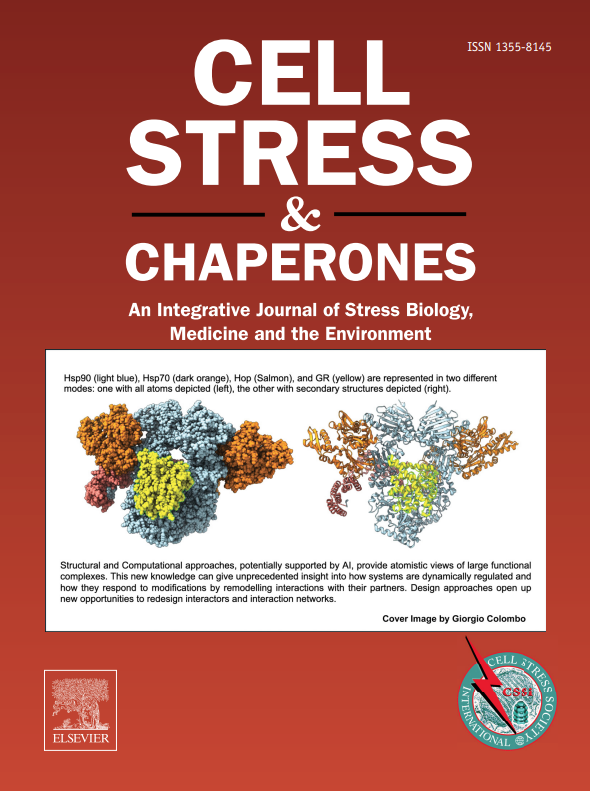The molecular chaperone Hsp70 from the thermotolerant Diptera species differs from the Drosophila paralog in its thermostability and higher refolding capacity at extreme temperatures
IF 3.3
3区 生物学
Q3 CELL BIOLOGY
引用次数: 0
Abstract
Previously, we demonstrated that species of the Stratiomyidae family exhibit higher tolerance to thermal stress in comparison with that of many representatives of Diptera, including Drosophila species. We hypothesized that species of this group inherited the specific structures of their chaperones from an ancestor of the Stratiomyidae family, and this enabled the descendants to colonize various extreme habitats. To explore this possibility, we cloned and expressed in Escherichia coli copies of the Hsp70 genes from Stratiomys singularior, a typical eurythermal species, and Drosophila melanogaster, for comparison. To investigate the thermal sensitivity of the chaperone function of the inducible 70-kDa heat shock proteins from these species, we used an in vitro refolding luciferase assay. We demonstrated that under conditions of elevated temperature, S. singularior Hsp70 exhibited higher reactivation activity in comparison with D. melanogaster Hsp70 and even human Hsp70. Similarly, S. singularior Hsp70 was significantly more thermostable and showed in vitro refolding activity after preheatment at higher temperatures than D. melanogaster paralog. Thermally induced unfolding experiments using differential scanning calorimetry indicated that Hsp70 from both Diptera species is formed by two domains with different thermal stabilities and that the ATP-binding domain of S. singularior is stable at temperatures 4 degrees higher than that of the D. melanogaster paralog. To the best of our knowledge, this study represents the first report that provides direct experimental data indicating that the evolutionary history of a species may result in adaptive changes in the structures of chaperones to enable them to elicit protective functions at extreme environments.
双翅目耐热物种的分子伴侣 Hsp70 与果蝇的同系物不同,它具有耐热性,在极端温度下具有更高的重折叠能力。
在此之前,我们已经证明,与包括果蝇在内的许多双翅目代表物种相比,鞘翅目蜓科的物种表现出更高的热应力耐受性。我们推测,该类物种继承了Stratiomyidae家族祖先的伴侣蛋白的特殊结构,这使得其后代能够在各种极端的栖息地定居。为了探索这种可能性,我们在大肠杆菌中克隆并表达了典型的欧热物种 Stratiomys singularior 和黑腹果蝇的 Hsp70 基因拷贝,以进行比较。为了研究这些物种的可诱导 70 kDa 热休克蛋白的伴侣功能的热敏感性,我们使用了体外再折叠荧光素酶试验。我们发现,在温度升高的条件下,奇异尾柱虫 Hsp70 与黑腹角蝇 Hsp70 甚至人类 Hsp70 相比,表现出更高的再激活活性。同样,S. singularior Hsp70的热稳定性也明显高于D. melanogaster同系物,并且在更高温度下预热后显示出体外重折叠活性。利用差示扫描量热法进行的热诱导解折实验表明,这两种双翅目昆虫的 Hsp70 都是由两个具有不同热稳定性的结构域组成的,而 S. singularior 的 ATP 结合结构域在比 D. melanogaster 准同源物高 4 度的温度下是稳定的。据我们所知,这项研究是第一份提供直接实验数据的报告,表明物种的进化史可能导致伴侣蛋白结构的适应性变化,从而使其在极端环境下发挥保护功能。
本文章由计算机程序翻译,如有差异,请以英文原文为准。
求助全文
约1分钟内获得全文
求助全文
来源期刊

Cell Stress & Chaperones
生物-细胞生物学
CiteScore
7.60
自引率
2.60%
发文量
59
审稿时长
6-12 weeks
期刊介绍:
Cell Stress and Chaperones is an integrative journal that bridges the gap between laboratory model systems and natural populations. The journal captures the eclectic spirit of the cellular stress response field in a single, concentrated source of current information. Major emphasis is placed on the effects of climate change on individual species in the natural environment and their capacity to adapt. This emphasis expands our focus on stress biology and medicine by linking climate change effects to research on cellular stress responses of animals, micro-organisms and plants.
 求助内容:
求助内容: 应助结果提醒方式:
应助结果提醒方式:


